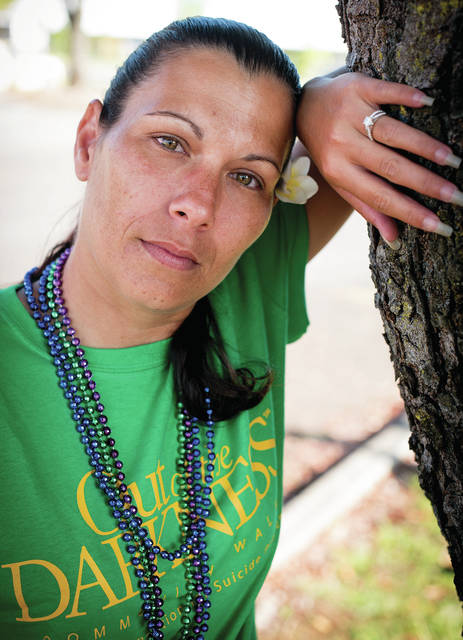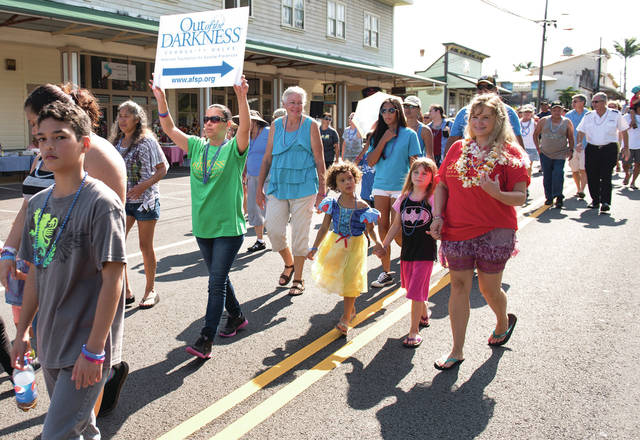Coming out of the darkness: Community walk aims to raise suicide awareness
WAIMEA — Almost everyone has been touched by suicide in one way or another, whether through a family member, friend, classmate or firsthand.
In Saydee Gabriel-Souza’s case six years ago, family support played an important role.
“I’m an attempted survivor,” she said matter of factly. “I’m thankful for all of those who stood by me and are still standing by me. It’s been years since I attempted, but every day is a new day for me. I still have my bad days but I won’t let depression win. Thank God I’m still here.”
Depression was something Gabriel-Souza struggled with from a young age. It escalated to suicidal tendencies when she became a young mother of four.
“I volunteered myself into Hilo Medical Center’s behavioral health facility because I told the doctors that if they let me go home, I was going to attempt to commit suicide again,” she said. “I woke up the next morning and reality dawned on me that I wasn’t home with my kids. I haven’t tried since.”
During her stay at the hospital, staff instructed her to write down everything she was feeling in a journal.
“It helped lift a weight off my shoulders,” Gabriel-Souza said. “I still do it.”
Nowadays, her motto is, “Fight the darkness and let the light shine.”
She has found other ways to deal with depression.
“One of them is to walk, along with talking to my family,” Gabriel-Souza said. “For mothers or family members my advice is: don’t talk, just listen to them.”
At first ashamed to come out and talk about what she went through, she later realized that by sharing her story she might be able help at least one other person. Now she sees people of all ages struggling with depression.
“Children may go to school or adults to work with a happy face, but it doesn’t mean they’re happy inside,” Gabriel-Souza said. “I have two girls that get bullied. It gives me flashbacks to high school when we called it being picked on. My children know what I’ve been through so I’m open and talk freely with them.”
She continued, “It’s important for parents to listen because kids say they need help in their own way. It’s also important not to judge.”
On Oct. 7, Gabriel-Souza will lead the Big Island Out of the Darkness Walk on the Waimea Elementary School field. A national campaign from the American Foundation for Suicide Prevention (AFSP), the walks started on the Big Island in 2014 in Honokaa and resumed last year in Hilo. Gabriel-Souza has her own Team Angels, a group of family and friends that walk together. Anyone can participate in the event that will go from the field to the police station and back.
“Team Angels represents those that we lost and those who are not ready to come out yet and share their story,” Gabriel-Souza said. “We are their voice. I’m walking to fight suicide and support AFSP’s bold goal to reduce the national suicide rate 20 percent by 2025.”
She hopes that least 100 will people participate in this year’s walk. Those who come out can heal along with others, supporting each other, she said. They may have lost someone, are personally struggling, or are veterans dealing with PTSD.
“We will make a difference together,” Gabriel-Souza said.
The event will include resource booths from the Prevent Suicide East Hawaii Task Force, Hilo Henna Hut, vendors and a memory board where families can post photos of their loved ones.
Check in will begin at 8 a.m., followed by the walk at 9 a.m. The deadline to register online is Oct. 6 at afsp.org/BigIsland, or in person the morning of the event.
Another suicide prevention advocate is Keli Acquaro, Hawaii Island’s branch chief of the Hawaii Family Guidance Center in the State Department of Health’s Child and Adolescent Mental Health Program. On Sept. 27 she will lead “A Suicide Talk” from 1-2:30 p.m. at Tutu’s House. Although the program is not intended to teach suicide intervention skills, Acquaro will discuss ways to support a person at risk and other opportunities for learning about intervention.
“There is a lot we could learn from each other that could help make our community safer from suicide,” she said. “We can start by talking to each other. Suicide is a community issue. It is preventable. What can we, as community members, do about this?”
According to Acquaro, between 2010 and 2014 there were 952 suicide attempts reported in Hawaii County and 180 people died by suicide. These numbers are actually higher than the statewide and national averages.
Suicide is also the leading cause of death in Hawaii for those ages 15-34. Among the signs are depression, restlessness, lack of sleep, or just wanting to do nothing. Bullying, relationship issues, feeling worthless and losing someone close can be triggers.
“People are often scared to talk about suicide because of the belief that talking about it might cause it to happen. But suicide is a part of the human condition, and making it taboo has not changed this reality. Sadly, this is especially true on the Big Island,” Acquaro added.
On a larger scale, National Suicide Prevention Week kicked off Sunday and will continue through this Saturday. Statewide events have also been planned throughout September by The Department of Health Injury Prevention Program in partnership with the Prevent Suicide Hawaii Task Force and Hawaii Chapter of the American Foundation for Suicide Prevention in recognition of National Suicide Prevention Month.
For North Hawaii residents battling depression and suicide, Kipuka o ke Ola (KOKO) offers services. They can be reached at 885-5900 or an access line is offered for emergencies 24/7 at 800-753-6879. In Honokaa, appointments can be made with the psychologist at Hamakua-Kohala Health Center by calling 775-7204.
Donations to support research, programs and advocacy done by the AFSP can be made now through Dec. 31 online at afsp.org/BigIsland.
Big Island Out of the Darkness Walk info: Contact Saydee Gabriel-Souza at 339-1794 or bigislandootdw@gmail.com




